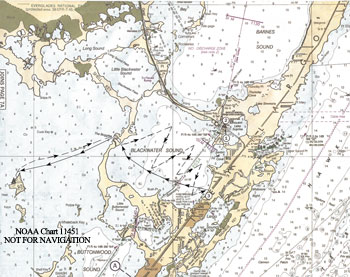
|
Florida Bay and
Blackwater Sound
|
|
Except for a few handfuls of hardy frostbitters, sailing stops in the Northeast
during the winter. What is a body to do, especially when the cravings start for
warm sunshine, blue skies and wavelets lapping the side of a boat? After vacationing
in many warm winter locales, we finally tried Key Largo, Florida. We were lured
by the proximity to Miami and Fort Lauderdale airports and an island location drivable
from the mainland. We loved it so much, we returned again this year.
After last year’s reconnaissance, we (read-my husband) decided to bring the toys.
After much discussion, modification and long lists, the brave little Scion-XB-that-could
was loaded up with one Sunfish, one Avon inflatable dinghy, one 3.3 hp Mercury outboard
engine, a dolly and all the other essential bits and pieces needed to make them
go, keep us safe and repair common breakages. And we managed to squeeze in two people,
clothes, etc.
After a harrowing drive down I-95, through wind and rain and over icy roads, we
arrived in Key Largo. Warm breezes wafted through palm trees, as the sun rose through
a sky dotted with fluffy white clouds, ahhhhh. After disassembling the Supercar,
freeing it of boat pieces and parts, it was time to go sailing.
The proposed voyage was in the works for one year. Information was gathered, charts
studied and the destination determined - North Nest Key within the Everglades National
Park. We launched the Sunfish EC (Everglades Cruiser) at the ramp next to the Caribbean
Club, a good dive bar, which had a cameo in Humphrey Bogart's Key Largo and a prominent
mention by Jimmy Buffet's A Pirate Looks at 50. Under the watchful eyes of the bar
patrons, we set sail on Blackwater Sound, equipped with ziploc bags filled with
a chart, binoculars, a flashlight, a hand-held VHF radio, a magnetic compass, a
cell phone, a camera, sunscreen, lunch and water.
North Nest Key is located in Florida Bay. It is a designated camping area of the
Everglades National Park. Our proposed course was to sail through the Boogies at
the Northeast side of Blackwater Sound. The Boogies creek is the only direct passage
into Florida Bay through the mangroves surrounded Blackwater Sound. Then head southwest
to North Nest Key.
|
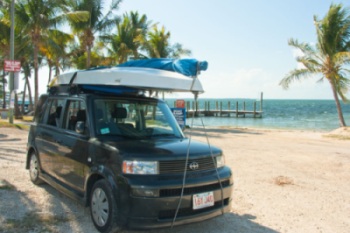
|
|
The Little Scion-XB-that-could
|
|
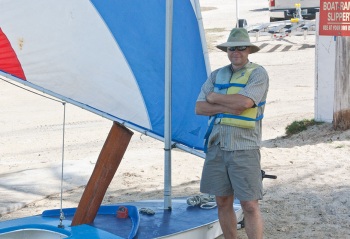
|
|
Sunfish EC
|
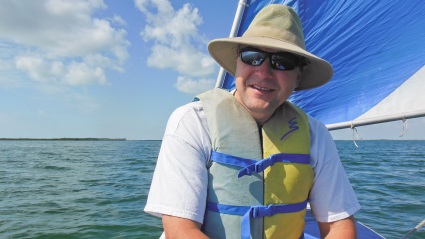
|
|
Blackwater Bay
|
With a light wind out of the southeast, we reached across the sound in a few hours.
The creek has day marks at the entrance. With a following current, we quickly slipped
through the 200 yard long passage, which is about 20 foot wide and 2-3 foot deep
with mangroves on each side. As we left the creek, Florida Bay opened up before
us. The aqua colored water, blue sky and warm temperature reminded us of the time
we spent in St. Croix in the USVI. Continuing on a beam reach, we headed to North
Nest Key.
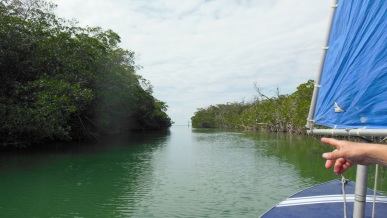
|
|
The Boogies
|
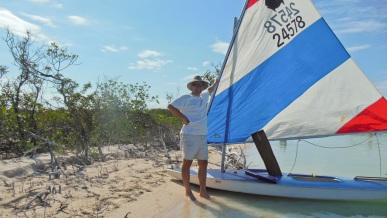
|
|
Landing on North Nest Key
|
By this time some of the drawbacks of the Sunfish EC started to be felt. We waited
with bated breath for the opportunity to stretch our legs onshore, not to mention
being able to ease the effects of the hard “bench”.
As we rounded the PVC pipe marked sand shoal, a white sand rimmed bay opened up
before us. Several boats were anchored a few feet off the beach along the shore.
We pulled in next to the only other sailboat - a Marshall catboat. We spent a pleasant
half-hour eating lunch and chatting with the catboat’s owners, who were also from
the Boston area.
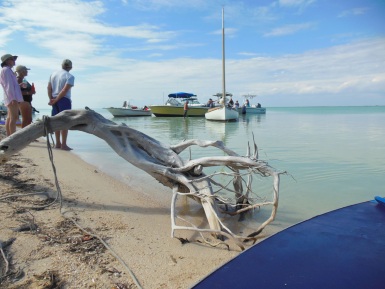
|
|
Driftwood
|
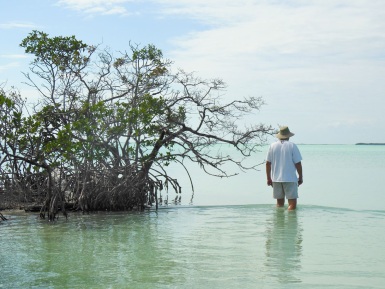
|
|
What is around the point?
|
Having a future camping trip in mind, we set off to investigate what facilities
were available. Our questioning of the beach population garnered the fact that there
was a pier with toilet facilities not far - just follow the shoreline. A short wade
along the beach and around the point revealed a startling sight. Extending out from
shore, a pier raised above the water about six feet with a ubiquitous toilet on
top, the kind you find at concerts, festivals and other crowd events - another sacrifice
to budget over beauty (sigh). We headed to the white sand beach, which extend out
from the water and up onto the island for about ten feet, where it reverted to the
natural state of a mangrove island – swamp land. We slogged down a path through
the swamp back to the beach where we had left the boat. I personally could not imagine
camping there and having to walk to the “facilities” during the night.
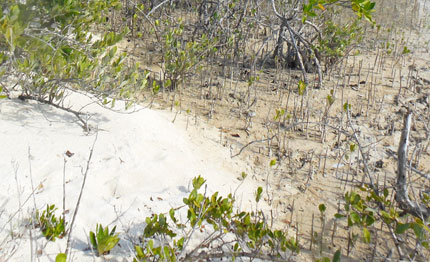
|
|
Man vs. Nature
|
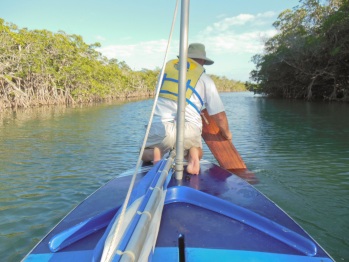
|
|
Oaring through the Boogies
|
Waving farewell to the other island visitors, we sailed back to the Boogies, again
on a beam reach. While sailing in this area, one of the amazing things you notice
is the adaption of nature. I spotted short mangrove sticks, standing vertically
upright floating by. On closer examination, you could see a few small leaves sprouting
on the above water portion. These sticks are carried by wind and currents to shallow
areas where they could take root. Much of Florida bay has depths less than five
feet, so it is not surprising that mangrove islands keep popping up.
Entering the Boogies, we found that the current was flowing against us. Captain
Jonas, centerboard in hand, took up position on the bow, while I manned the tiller,
and we rowed back into Blackwater Sound at 4pm. During the day, the light southeast
breeze backed toward the east making it necessary to tack back to the ramp. With
wind and current against us, it took us four hours to sail the last quarter of the
trip (about the same time it took to sail the first three-quarters). But as we watched
the sun set and the twilight descend into darkness, we also spotted manatees, dolphins
and a variety of birds.
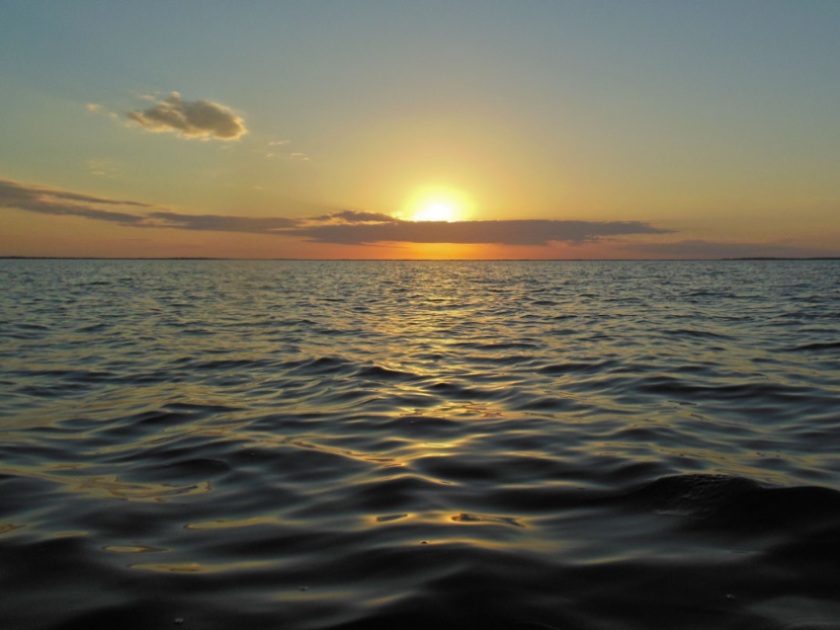
|
|
Sunset on the Everglades
|
As the sky darkened and the lights on shore lit up, we made sure to spot the lights
at our destination with binoculars. We knew we would be sailing in the darkness
for at least two hours or longer if the wind died. It was important to note several
areas along the coast, so that our destination lights could be distinguish from
others. As we crossed the Intercoastal Waterway and the Everglades NP boundary,
we periodically lit up the sail with our flashlight. The Sunfish EC was not equipped
with navigation lights and power boats were still running up and down the shoreline.
We ghosted along under the starry sky with energetic music echoing and BBQ smells
wafting from the shore. As our destination neared, we feared that the breeze would
disappear. Thankfully, only the approaching shore blocked the wind, forcing us to
row for the last 200 feet. As we beached the boat, our sense of accomplishment buoyed
us through stowing the Sunfish, dinner and a shower through to a well-deserved rest.
<- Back